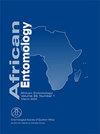Mosquito community composition in Central District, Botswana: insights from a malaria endemic to non-endemic gradient
IF 1.2
4区 农林科学
Q3 ENTOMOLOGY
引用次数: 0
Abstract
Spatial distribution of vector mosquitoes plays a critical role in the dynamics of associated diseases’ spread across diverse landscapes. In Botswana, six Districts are implicated as malaria endemic zones, one of which is the Central District comprising both malaria endemic and non-endemic sub-districts. Despite being the biggest in the country, mosquito diversity in this District is under-explored, more so in the malaria non-endemic sub-districts. Here, we thus sampled mosquito adults and larvae from the malaria endemic sub-district of Bobirwa and non-endemic sub-districts of Palapye and Serowe, to determine spatial mosquito abundance and diversity in the District. Overall, all the sub-districts had a representation of key mosquito taxa of medical and economic importance (Aedes, Culex and Anopheles), irrespective of malarial endemicity status. Bobirwa had the highest number of mosquitoes sampled (429) although the greatest species richness (0.8511) was observed from Palapye. Moreover, Palapye also recorded a species from another genus, Culiseta longiareolata, a known natural vector of avian malaria parasites. Given global climate shift projections for the region, there is a need for continuous area-wide surveillance for vector mosquitoes and associated parasites in curbing the risk of emerging and re-emerging infections. While the Anopheles-centric approach to mosquito control is still necessary, a holistic approach, incorporating other vector incriminated mosquito species is warranted, particularly given shifting climates and the presence of invasive disease associated vector mosquito species.博茨瓦纳中区蚊子群落组成:从疟疾流行到非流行的梯度
媒介蚊子的空间分布在相关疾病在不同景观中传播的动态中起着关键作用。在博茨瓦纳,有六个区被列为疟疾流行区,其中一个区是由疟疾流行区和非流行区组成的中央区。尽管该地区是全国最大的地区,但对蚊子多样性的探索不足,在疟疾非流行分区更是如此。因此,在这里,我们对Bobirwa疟疾流行分区以及Palapye和Serowe非流行分区的蚊子成虫和幼虫进行了采样,以确定该地区蚊子的空间丰度和多样性。总的来说,所有分区都有一个具有医学和经济重要性的关键蚊子分类群(伊蚊、库蚊和按蚊)的代表,无论疟疾的流行状况如何。Bobirwa的蚊子样本数量最多(429只),尽管在Palapye观察到的物种丰富度最高(0.8511只)。此外,Palapye还记录了另一个属的一个物种,长形库蚊,一种已知的鸟类疟疾寄生虫的天然媒介。鉴于该地区的全球气候变化预测,有必要对病媒蚊子和相关寄生虫进行持续的全地区监测,以遏制新出现和再次出现感染的风险。虽然以按蚊为中心的蚊子控制方法仍然是必要的,但有必要采取一种综合方法,将其他与媒介相关的蚊子物种纳入其中,特别是考虑到气候的变化和与疾病相关的入侵媒介蚊子物种的存在。
本文章由计算机程序翻译,如有差异,请以英文原文为准。
求助全文
约1分钟内获得全文
求助全文
来源期刊

African Entomology
生物-昆虫学
CiteScore
2.00
自引率
0.00%
发文量
17
审稿时长
6-12 weeks
期刊介绍:
African Entomology (ISSN 1021-3589 – print / 2224-8854 – online) replaced the old Journal of the Entomological Society of Southern Africa in 1993. A single volume consisting of two issues (March and September) is published annually. The journal is indexed in all major abstracting journals
African Entomology is a peer reviewed scientific journal that publishes original research articles and short communications on all aspects of entomology, with an emphasis on the advancement of entomology on the African continent.
 求助内容:
求助内容: 应助结果提醒方式:
应助结果提醒方式:


